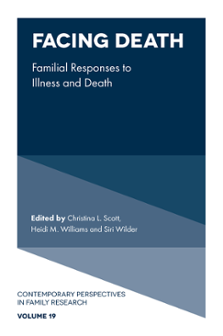
Index
Facing Death: Familial Responses to Illness and Death
ISBN: 978-1-80382-264-8, eISBN: 978-1-80382-263-1
ISSN: 1530-3535
Publication date: 16 June 2022
Citation
(2022), "Index", Scott, C.L., Williams, H.M. and Wilder, S. (Ed.) Facing Death: Familial Responses to Illness and Death (Contemporary Perspectives in Family Research, Vol. 19), Emerald Publishing Limited, Leeds, pp. 191-196. https://doi.org/10.1108/S1530-353520220000019009
Publisher
:Emerald Publishing Limited
Copyright © 2022 Christina L. Scott, Heidi M. Williams and Siri Wilder
INDEX
- Prelims
- Section 1: Coping with Serious Illness and Threat of Death
- Chapter 1: Intimate Relationships as Factors in Associations Between Inflammation and Happiness in Older Adults: A Covariate Analysis of Limited Longitudinal Data
- Chapter 2: Facing Amyotrophic Lateral Sclerosis Under Lockdown: The Experiences of Minors
- Chapter 3: Navigating Discussions of Death with Young Children: Variable Strategies of Protection
- Section 2: Decisions Surrounding Serious Illness and End of Life
- Chapter 4: Familial Responses to Death in Veterans Affairs Medical Centers: Losing Control and Holding On
- Chapter 5: Choosing Abortion for a Serious Fetal Health Issue: From Medical Information to Values
- Section 3: Facing Death and Bereavement
- Chapter 6: Social Support in Bereavement: The Experiences of Support Following Spousal Loss in Families with Dependent Children
- Chapter 7: Grieving Together: Dyadic Trajectories and Reciprocal Relations in Parental Grief After Child Loss
- Chapter 8: Suicide Bereavement and Social Relationships: A New Application of Durkheim
- Index